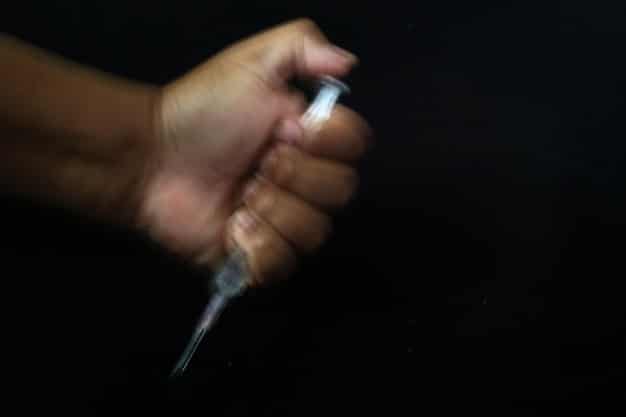White House Unveils $2B Opioid Crisis Combat Plan

The White House has announced a significant new initiative to combat the escalating opioid crisis, allocating an unprecedented $2 billion in funding to expand access to treatment, bolster prevention efforts, and support recovery services nationwide.
The White House has just announced a robust new initiative to combat the opioid crisis, a public health emergency that continues to devastate communities across the nation. This comprehensive plan involves the allocation of $2 billion in funding to combat the opioid crisis, signaling a renewed, large-scale commitment to addressing this complex challenge head-on. As a critical issue demanding immediate and sustained attention, understanding the full scope of this federal response is paramount for citizens, healthcare providers, and policymakers alike.
Understanding the Scale of the Opioid Crisis in the US
The opioid crisis represents one of the most profound public health challenges facing the United States today, transcending demographics and socioeconomic boundaries. Its origins are multifaceted, rooted in a combination of overprescription of opioid pain relievers in the past, an increase in the availability of illicit opioids like fentanyl, and systemic issues within healthcare and addiction treatment. The human cost is immeasurable, marked by hundreds of thousands of overdose deaths, shattered families, and strained community resources. This widespread devastation underscores the urgent need for comprehensive and sustained intervention from all levels of government, particularly federal bodies with the capacity to coordinate nationwide responses and allocate substantial resources. The crisis has evolved over several waves, starting with prescription opioids, moving to heroin, and most recently, being dominated by synthetic opioids such as fentanyl, which dramatically amplify the risk of fatal overdose due to their potency.
The sheer volume of lives lost and the profound societal impact necessitate a multifaceted approach, one that not only addresses the immediate dangers of overdose but also tackles the underlying factors contributing to addiction. Healthcare systems are often overwhelmed, lacking the infrastructure and personnel to adequately cope with the demand for treatment and prevention services. Furthermore, the stigma associated with addiction often prevents individuals from seeking help, compounding the problem.
The Public Health Emergency Declaration
The opioid crisis was officially declared a national public health emergency, a designation that
highlighted its severity and paved the way for intensified federal action. This declaration served
as a rallying cry for public and private sectors to collaborate on solutions. It underscored that
this was not merely a criminal justice issue but a complex health challenge requiring a vast array
of public health interventions, from harm reduction strategies to robust expansion of treatment
options. The declaration also streamlined certain regulatory processes, enabling a more rapid
deployment of resources and waivers to increase access to care.
Key Statistics and Trends
Understanding the trajectory of the crisis requires an examination of key statistical data. Trends
reveal a disturbing escalation in overdose deaths, particularly those involving synthetic opioids.
Data from the Centers for Disease Control and Prevention (CDC) consistently show alarming figures,
with provisional data often indicating record high numbers of overdose fatalities.
- Overdose Deaths: Annual overdose deaths have consistently risen, with synthetic opioids like
fentanyl being the primary driver in recent years. - Age Demographics: The crisis disproportionately affects working-age adults, leading to significant
economic and social disruption. - Geographic Impact: While pervasive, some regions, particularly in the Appalachian and industrial
Midwest areas, have been hit harder than others, reflecting economic distress and healthcare
disparities. - Substance Overlap: Polysubstance use, involving opioids combined with other drugs like
stimulants, is becoming increasingly common, complicating treatment and increasing overdose risk.
The impact extends beyond fatalities to include a myriad of non-fatal overdoses, increased rates of
infectious diseases like HIV and hepatitis C due to injection drug use, and a significant strain
on emergency services, law enforcement, and child welfare systems. The economic burden, encompassing
healthcare costs, lost productivity, and criminal justice expenses, runs into hundreds of billions
of dollars annually. This grim reality makes the newly announced White House initiative a critical
and timely intervention, aiming to reverse these devastating trends and provide hope for recovery.
The approach must be comprehensive, addressing the root causes and providing broad support.
Behind the $2 Billion Allocation: Where Will the Funding Go?
The announcement of a $2 billion allocation to combat the opioid crisis is a significant financial commitment, but its true impact hinges on how these funds are strategically dispersed. This substantial investment aims to address the crisis from multiple angles, focusing on areas identified as critical gaps in the current response. The allocation reflects a deeper understanding of the crisis’s complexity, recognizing that a unified approach encompassing prevention, treatment, and recovery is essential for long-term success. Understanding the specific targets for these funds is crucial for appreciating the potential reach and effectiveness of the new White House initiative. This funding is not merely a lump sum, but a carefully planned infusion into various mechanisms designed to buttress existing efforts and pioneer new ones.
Expanding Access to Treatment and Medication-Assisted Treatment (MAT)
A significant portion of the allocated funds is earmarked for expanding access to evidence-based treatment, particularly Medication-Assisted Treatment (MAT). MAT, which combines behavioral therapy and medications like buprenorphine, methadone, and naltrexone, has been proven highly effective in treating opioid use disorder (OUD), reducing overdose deaths, and improving long-term recovery outcomes. Despite its effectiveness, access to MAT has been historically limited due to regulatory hurdles, lack of trained providers, and stigma. The new funds aim to dismantle these barriers.
- Increased Provider Training: Funds will support training for more healthcare professionals to prescribe MAT, particularly in underserved areas.
- Telehealth Expansion: Investment in telehealth infrastructure to deliver MAT services remotely, especially critical for rural communities.
- Integrated Care Models: Promoting the integration of OUD treatment into primary care settings and emergency departments.
- Buprenorphine Access: Reducing barriers to obtaining buprenorphine, the most accessible form of MAT, by supporting initiatives to streamline its prescription.
Bolstering Prevention Efforts
Prevention is a cornerstone of any effective public health strategy, and a substantial portion of the new funding will be directed towards upstream interventions designed to prevent opioid use disorder before it starts. This includes public awareness campaigns, educational programs for healthcare providers on responsible prescribing practices, and community-based initiatives that address underlying risk factors for substance use.
The goal is to shift public perception surrounding addiction, moving away from stigma and towards a health-oriented approach. This involves educating younger generations about the dangers of opioid misuse and providing alternatives for healthy coping mechanisms. Community-level interventions will be tailored to specific local needs, recognizing that prevention strategies need to be adaptive. These include programs aimed at reducing the availability of illicit substances and safely disposing of unused prescription opioids.
Supporting Recovery Services and Harm Reduction
Beyond acute treatment, the longevity of recovery hinges on robust support systems. The $2 billion funding will also extend to bolstering recovery support services, which are critical for individuals transitioning from active addiction to sustained sobriety. These services include housing, employment assistance, peer support programs, and mental health counseling. Concurrent with recovery, the initiative also allocates funds to harm reduction strategies. These strategies aim to reduce the negative consequences of drug use, such as infectious disease transmission and overdose deaths, for individuals who are not yet ready or able to stop using drugs.
Harm reduction includes the distribution of naloxone, a life-saving overdose reversal medication, and the establishment of syringe service programs. These multifaceted investments reflect a comprehensive approach, recognizing that no single intervention will solve the crisis but rather a combination of interconnected strategies. The ultimate objective is to create a more resilient and supportive environment for individuals at every stage of their journey with opioid use disorder. This involves a sustained commitment and adaptability.
Integrated Approaches: A Holistic Strategy for Combatting Addiction
Combatting the opioid crisis effectively demands more than isolated interventions; it requires an integrated, holistic strategy that addresses the complex interplay of factors contributing to addiction. The new White House initiative, with its substantial funding, aims to foster such an approach, recognizing that the crisis stems from intertwined medical, social, and economic determinants. A truly comprehensive strategy must bridge the common divides between public health, law enforcement, and social services, fostering collaboration rather than siloed efforts. This integration is vital for creating a seamless continuum of care, from prevention to recovery, ensuring that individuals receive timely and appropriate support at every stage.
The goal is to move beyond reactive measures to proactive solutions, building resilient communities capable of addressing current challenges and mitigating future ones. This holistic strategy acknowledges that addiction is a chronic disease influenced by various factors, including genetic predispositions, mental health conditions, environmental stressors, and trauma. Therefore, effective interventions must be equally varied and adaptable.
Connecting Physical and Mental Health
One critical aspect of an integrated approach is the seamless connection between physical and mental health services. Many individuals struggling with opioid use disorder also contend with co-occurring mental health conditions such as depression, anxiety, or PTSD. Treating these conditions in isolation is often ineffective. The initiative seeks to promote integrated models of care where mental health screening and treatment are routinely offered alongside substance use disorder treatment, and vice versa. This ensures a more complete and effective path to recovery.
Community-Based Solutions and Local Partnerships
The opioid crisis manifests differently in various communities, each with unique challenges and resources. A holistic strategy must therefore empower local communities and foster strong partnerships between federal, state, and local entities, as well as community organizations, faith-based groups, and private citizens. This localized approach allows for tailored interventions that are culturally competent and responsive to specific community needs.
Law Enforcement and Public Health Collaboration
Historically, the response to the opioid crisis often placed a heavy emphasis on law enforcement and criminal justice interventions. While addressing illicit drug trafficking remains crucial, a holistic strategy recognizes the importance of shifting the paradigm towards a public health-first approach. This involves fostering collaboration between law enforcement and public health professionals, where law enforcement can play a role in connecting individuals with treatment options rather than solely focusing on punitive measures. This collaborative model, often seen in deflection programs, helps steer individuals away from the criminal justice system and towards care.
For example, police officers might carry naloxone to reverse overdoses or be trained to refer individuals found with small amounts of drugs directly to treatment programs instead of arresting them. This shift acknowledges that addiction is a disease, not a moral failing, and that treatment is a more effective long-term solution than incarceration for addressing the public health dimensions of the crisis. These integrated efforts create a more compassionate and effective system, moving closer to resolving the long-standing challenges associated with opioid use disorder.
Challenges and Opportunities on the Road Ahead
While the White House’s new initiative and its substantial funding represent a monumental step forward in fighting the opioid crisis, the path ahead is not without its challenges. The scale and complexity of the crisis mean that even a $2 billion allocation, while significant, must be deployed with precision and accountability to maximize its impact. Moreover, the dynamic nature of the illicit drug supply, consumer trends, and existing systemic barriers present ongoing hurdles that require constant adaptation and innovation. However, alongside these challenges, there are also immense opportunities to leverage this unprecedented investment to truly transform the landscape of addiction prevention, treatment, and recovery in the nation.
Overcoming Stigma and Public Perception
One of the most persistent barriers to effective opioid crisis response is the pervasive stigma associated with addiction and drug use. This stigma often prevents individuals from seeking help, discourages healthcare providers from offering treatment, and undermines public support for vital harm reduction and recovery initiatives. Overcoming this requires a concerted effort to shift public perception, framing addiction as a chronic disease rather than a moral failing. Public awareness campaigns funded by the initiative can play a crucial role in dismantling these harmful stereotypes.
Ensuring Equitable Access and Addressing Disparities
Despite federal funding, ensuring equitable access to treatment and prevention services across all communities remains a significant challenge. Rural areas, underserved urban communities, and minority populations often face greater barriers to accessing care due to a lack of infrastructure, transportation issues, economic hardship, and systemic biases. The opportunity lies in specifically directing funds to address these disparities, building capacity where it is most needed, and developing culturally competent programs that resonate with diverse populations. This approach means tailoring interventions to meet the specific needs of these groups.
The Evolving Illicit Drug Supply
The illicit drug market is constantly evolving, with new, highly potent synthetic opioids rapidly emerging and displacing others. Fentanyl, its analogues, and now rising concerns about xylazine (a non-opioid sedative sometimes mixed with opioids) pose significant threats, increasing overdose risks and complicating treatment. This dynamic landscape demands that prevention and treatment strategies remain agile and adaptable, backed by continuous research and real-time data analysis to effectively respond to emerging threats. Opportunities lie in rapid testing for new substances, enhanced surveillance, and swift dissemination of updated prevention and treatment protocols.
Sustaining Momentum and Long-Term Commitment
A substantial one-time investment is critical, but sustained momentum and long-term commitment are equally vital for truly combating the opioid crisis. Addiction is a chronic, relapsing disease, and effective solutions require ongoing support and funding over many years. The challenge will be to ensure that this initiative lays the groundwork for sustainable programs and policies that can outlast political cycles and continue to address the crisis for generations to come. The opportunity resides in building robust, resilient systems that are not dependent on sporadic funding surges but are instead integrated into public health infrastructure. This includes advocating for consistent funding streams and policies that promote long-term stability and growth in addiction services.
Success Stories and Promising Models
Amidst the challenging landscape of the opioid crisis, there are numerous beacons of hope: communities, organizations, and individuals who have developed and implemented promising models of intervention. These success stories offer invaluable insights and demonstrate that effective strategies, particularly those focused on compassionate, evidence-based care, can make a tangible difference. The new White House initiative offers a vital opportunity to scale up these proven models, disseminating best practices nationwide and building a collective body of knowledge that can accelerate progress. Highlighting these successes can also inspire other communities and reinforce the importance of continued investment and innovation.
Community-Led Overdose Prevention Programs
Many communities have taken proactive steps to reduce overdose fatalities through local, grassroots efforts. These programs often involve peer-led naloxone distribution, community training on overdose recognition and response, and the establishment of harm reduction centers. In areas particularly hard-hit by the crisis, these community-based initiatives have dramatically reduced overdose mortality rates by empowering individuals to save lives and normalizing access to life-saving tools.
One striking example is found in parts of Appalachia, where grassroots organizations, often fueled by individuals in recovery and family members of those affected, have created robust networks for naloxone distribution. They often partner with local health departments and first responders to ensure wide availability of the overdose reversal medication, coupled with compassionate education on its use. These networks also serve as crucial entry points for individuals seeking treatment or other support services. This bottom-up approach emphasizes community ownership and resilience in the face of adversity, proving to be far more effective than top-down mandates alone.
Integrated Treatment Pathways
Successful treatment models often involve deeply integrated care that addresses not only substance use disorder but also co-occurring mental health conditions and broader social determinants of health. These pathways often involve multidisciplinary teams, including physicians, therapists, social workers, and peer recovery specialists, working collaboratively to provide comprehensive support. The success of these models lies in their ability to treat the whole person, recognizing that addiction is rarely an isolated issue.
For instance, some hospital emergency departments have implemented “warm hand-off” programs, where individuals who present with an overdose or opioid-related issue are immediately connected with a peer recovery coach or a treatment specialist. This immediate linkage drastically increases the likelihood of an individual entering and staying in treatment, capitalizing on a moment of crisis to initiate a path to recovery. These programs prioritize rapid access to care, removing traditional barriers like waiting lists and complex intake procedures, which often deter individuals seeking help.
Innovation in Prevention and Education
Beyond traditional public health campaigns, innovative prevention programs are emerging that target specific populations and address underlying risk factors. These include school-based prevention curricula that foster resilience and teach coping mechanisms, as well as programs that engage parents and caregivers in discussions about safe medication storage and disposal. Some initiatives also focus on diverting youth away from substance use by providing positive alternatives and mentorship. The effectiveness of these programs lies in their tailored approach and their ability to engage stakeholders across various sectors, creating a protective environment for young people. These models often utilize digital platforms and social media to reach wider audiences with targeted messaging, making prevention education more accessible and engaging.
The Role of Data and Technology in Crisis Response
In the ongoing battle against the opioid crisis, data and technology are emerging as indispensable tools, shifting the approach from reactive to proactive and enabling more precise, evidence-based interventions. The sheer volume of information related to overdose trends, treatment outcomes, and illicit drug flows can be overwhelming, but when effectively managed and analyzed, it becomes a powerful asset. The White House’s new initiative implicitly recognizes this, and smart allocation of funds will undoubtedly bolster the technological infrastructure needed for a more agile and intelligent response.
This includes not only the collection of raw numbers but also their interpretation to reveal patterns, predict surges, and pinpoint areas of vulnerability. Advanced analytics, artificial intelligence, and robust data-sharing platforms can transform how public health officials, law enforcement, and treatment providers identify, track, and ultimately mitigate the crisis. The objective is to move beyond mere reporting to actionable intelligence that can guide policy and on-the-ground efforts.
Leveraging Real-Time Overdose Data
Access to real-time, granular data on overdose incidents is crucial for rapid response and resource deployment. This includes data from emergency medical services, hospitals, and law enforcement. Technologies that allow for quick reporting and sharing of this information can signal emerging hotspots, identify novel drug threats, and enable targeted interventions such as naloxone distribution or mobile outreach teams. This immediate feedback loop is vital for staying ahead of the crisis curve.
Predictive Analytics for Trend Identification
Beyond current reporting, predictive analytics can forecast future trends in opioid use and overdose. By analyzing historical data, demographic information, and social determinants, algorithms can identify communities at higher risk, allowing for proactive allocation of resources for prevention and treatment. This forward-looking approach helps in optimizing the deployment of limited resources, ensuring that intervention efforts are focused where they are most needed and before a crisis escalates.
Enhancing Telehealth and Digital Health Solutions
The COVID-19 pandemic significantly accelerated the adoption of telehealth, and this technology holds immense promise for expanding access to addiction treatment, particularly in rural and underserved areas. Virtual consultations, remote monitoring, and digital platforms for behavioral therapy can overcome geographical barriers and reduce the stigma associated with seeking in-person care. The new funding can be instrumental in building out the infrastructure and training necessary to sustain and expand these vital digital health solutions, ensuring that treatment is more accessible and convenient for a wider population.
Data Sharing and Interoperability
For a truly integrated response, seamless data sharing across different agencies and healthcare systems is paramount. This involves developing interoperable platforms that allow for the secure exchange of patient information, treatment protocols, and public health surveillance data. Breaking down data silos ensures that all stakeholders have a comprehensive view of the crisis, fostering better coordination and more effective strategies. Technology can facilitate this by establishing secure, standardized data exchange protocols, ensuring privacy while maximizing collective intelligence. The goal is to create a national data ecosystem that informs policy at every level.
Policy Implications and Future Directions
The White House’s new initiative signals a significant policy shift, moving towards a more aggressive and potentially transformative approach to the opioid crisis. This substantial financial commitment carries with it profound implications for federal, state, and local policies, shaping future directions in public health, criminal justice, and social welfare. The challenge will be to ensure that this influx of funding translates into sustainable policy changes that address the root causes of the crisis and build long-term resilience within communities. This is not merely about spending money but about strategically investing in systemic solutions that can endure beyond the immediate crisis.
Reforming Prescribing Practices and Medical Education
A key policy implication will be a continued emphasis on reforming opioid prescribing practices. While significant progress has been made, further integration of safe prescribing guidelines into medical education and ongoing professional development will be crucial. Policies supporting alternative pain management strategies and discouraging an over-reliance on opioids will also be vital. This involves a shift in medical culture, emphasizing non-pharmacological and non-opioid pain treatments as first-line therapies.
Strengthening Harm Reduction Policies
The increasing recognition of harm reduction as a critical component of public health strategy will likely lead to policies that facilitate broader access to naloxone, expand syringe service programs, and potentially explore other evidence-based harm reduction interventions. These policies acknowledge that meeting people where they are, reducing risk, and saving lives are essential steps, even if individuals are not yet ready for full recovery. This often means providing legal and financial support for these programs.
Integrated Behavioral Health and Housing Support
Looking forward, there will be a continued push for policies that integrate behavioral health services more seamlessly into primary care and ensure access to stable housing as a cornerstone of recovery. Recognizing that addiction is deeply intertwined with mental health and social determinants, future policies will likely emphasize comprehensive support systems that treat the whole person, rather than solely focusing on substance cessation. This includes fostering multidisciplinary teams and service integration.
Federal and State Collaboration
The success of this initiative will heavily depend on robust collaboration between federal and state governments. Federal funding often comes with guidelines and expectations, and states will need to align their policies and resource allocation to effectively utilize these funds. Opportunities exist for developing innovative federal-state partnerships that allow for flexibility tailored to specific state needs while maintaining national strategic objectives. This collaborative approach ensures that federal resources are adapted and maximized at the local level, where the impact is most directly felt. The long-term success hinges on this sustained, coordinated effort.
| Key Point | Brief Description |
|---|---|
| 💊 $2B Funding | Significant investment to scale up opioid crisis response efforts nationwide. |
| 🏥 Treatment Access | Expands Medication-Assisted Treatment (MAT) and telehealth services for OUD. |
| 🛡️ Prevention Focus | Invests in public awareness and community programs to prevent opioid misuse. |
| 🤝 Holistic Approach | Promotes integrated care, combining mental health, physical health, and recovery support. |

Frequently Asked Questions About the Opioid Crisis Initiative
The primary goal is to significantly escalate efforts against the opioid crisis by expanding access to evidence-based addiction treatment, strengthening prevention programs, and enhancing recovery support services across the United States. It aims to reduce overdose deaths and reduce the health and social impact of opioid use disorder.
The $2 billion will be allocated across various key areas. Significant portions are earmarked for expanding Medication-Assisted Treatment (MAT), bolstering community-based prevention initiatives, improving access to recovery support services, and supporting harm reduction measures like naloxone distribution, all prioritizing evidence-based practices.
MAT combines behavioral therapy with medications (such as buprenorphine, methadone, or naltrexone) to treat opioid use disorder. It is crucial because it’s scientifically proven to reduce opioid cravings, prevent relapses, and decrease the risk of overdose. The funding aims to make MAT more widely accessible and reduce barriers to its use.
While the initiative broadly addresses opioid misuse, its emphasis on harm reduction (like naloxone distribution), expanded treatment access (including for fentanyl-related overdoses), and public awareness campaigns about potent synthetic opioids directly confronts the dangers of fentanyl. It also supports interdiction efforts to deter the flow of illicit fentanyl.
Community organizations are expected to play a vital role. The initiative emphasizes supporting and partnering with local grassroots efforts, non-profits, and faith-based groups. These organizations are often at the forefront of providing direct services, prevention education, and recovery support, making them critical partners in implementing and tailoring strategies at the local level.

Conclusion
The White House’s new initiative, backed by a substantial $2 billion allocation, marks a pivotal moment in the nation’s ongoing struggle against the opioid crisis. Far from being a mere legislative gesture, it represents a comprehensive commitment to addressing this multifaceted public health emergency through expanded access to treatment, bolstered prevention efforts, and strengthened recovery support services. This holistic approach signals a crucial shift towards evidence-based, compassionate care, aiming to dismantle the systemic barriers that have long impeded effective intervention. While challenges undoubtedly remain, the strategic investment in community-based solutions, integrated care models, and technological advancements offers a genuine opportunity to reverse devastating trends and build a more resilient future for countless individuals and families impacted by addiction. The success of this initiative will ultimately hinge on collaborative efforts across all levels of government, healthcare providers, and community stakeholders, working in unison to translate this ambitious funding into tangible, life-saving outcomes across the United States.





